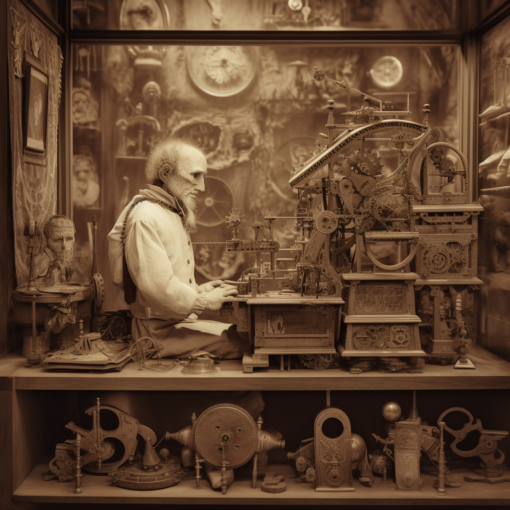Greetings, kindred spirits and lifelong learners!
Today, we embark on a different sort of journey, one which traverses not physical terrains but rather, the landscape of human intellect. Our expedition today will delve into the realms of written communication, from the primitive pictographs of yesteryears to the alphabets we so effortlessly glide our pens across today.
Written communication, dear readers, is not just a way of expressing our thoughts but a testament to human ingenuity and persistence. Each symbol and letter is an echo from our ancestors, carrying the whispers of centuries, silently shaping the world as we know it. This, my dear friends, is the enchanting odyssey of the alphabet.
Picture, if you will, the humble beginnings of our journey. In a time when civilization was but a fledgling, our ancestors painted their stories on cave walls. These pictographs, more art than letters, were humanity’s first attempts at freezing time, capturing a moment of life for posterity.
As humanity grew more complex, so did our methods of communication. The next great leap was the invention of the cuneiform script by the Sumerians. The birth of cuneiform marked a significant shift from pictorial representations to abstract symbols, making it possible to express not just things, but abstract concepts and ideas.
Yet, the elegance and efficiency of alphabets were still to be realized. Enter the Phoenicians, the legendary seafarers and traders of the ancient world. Their brilliant invention of an alphabet transformed written communication into an efficient tool for record-keeping and dissemination of ideas. The genius of this alphabet lay in its simplicity: a small set of symbols, each representing a sound, which could be combined to express any word or idea.
From the Phoenicians, this art of writing spread across the globe. It evolved as it travelled, creating the scriptural symphony we know today: the flowing curves of Arabic, the intricate beauty of Chinese characters, the simple elegance of the Latin script, each a unique note in the grand harmony of human communication.
And so, dear reader, here we stand today, beneficiaries of an evolutionary process that spans millennia, expressing our most profound thoughts and mundane musings alike through alphabets. We are all connected by this shared heritage, an intangible thread that ties our present to the past, and pens our future.
It has been said that the past is a foreign country. If that is so, the alphabet is our passport, a vessel that carries us across the ocean of time, letting us touch and shape the shores of tomorrow. Every letter penned, every word spoken, is a step on this ongoing odyssey.
In our journey today, we have traversed the tapestry of time, witnessed the evolution of human intellect and communication. From the silent whispers of pictographs to the eloquent elegance of alphabets, we’ve seen how the evolution of written communication reflects the growth of humanity itself.
Till our next intellectual sojourn, dear friends. Remember, every word you pen is a continuation of this grand narrative, every letter, a stitch in the rich tapestry of human history.
Yours in discovery,
Percival

Sure, here are a few resources for further reading:
- History of Writing Systems: Dive into the depths of how different writing systems emerged and evolved over the millennia.
- The Development of Writing: A comprehensive article detailing the evolution of various writing systems around the world.
- Phoenician Alphabet: Learn more about how the Phoenicians’ brilliant invention transformed written communication.





11 thoughts on “The Alphabet Odyssey: An Exploration of Written Communication”
Can you be more specific about the content of your article? After reading it, I still have some doubts. Hope you can help me. https://www.binance.com/cs/join?ref=S5H7X3LP
Thank you for your sharing. I am worried that I lack creative ideas. It is your article that makes me full of hope. Thank you. But, I have a question, can you help me?
Can you be more specific about the content of your article? After reading it, I still have some doubts. Hope you can help me.
Your article helped me a lot, is there any more related content? Thanks!
Your article helped me a lot, is there any more related content? Thanks!
Can you be more specific about the content of your article? After reading it, I still have some doubts. Hope you can help me.
Thanks for sharing. I read many of your blog posts, cool, your blog is very good. 註冊
Just signed up for WinPH5! The platform looks promising, and the welcome bonus is a nice touch. Hoping to win big, wish me luck! winph5
Together with every thing which appears to be developing inside this particular area, your opinions tend to be very radical. Having said that, I appologize, because I can not give credence to your entire suggestion, all be it exhilarating none the less. It would seem to everybody that your comments are actually not entirely rationalized and in reality you are yourself not even fully confident of your argument. In any case I did appreciate reading it.
Alright gamers, one888vn.com caught my eye. The vibes are good and the games seem legit. Give it a whirl and see if it’s your jam! You can find it at one888vn.com.
I was suggested this website by my cousin. I am not sure whether this post is written by him as no one else know such detailed about my trouble. You are wonderful! Thanks!